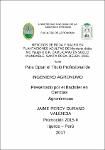Métodos de poda y raleo en plantaciones adultas de Myrciaria dubia MC Vaugh H.B.K. camu-camu en suelo inundable, Santa Rosa, Belén, 2016
Abstract
El presente trabajo de investigación se llevó a cabo en la comunidad de Santa Rosa, Río Amazonas, distrito de Belén, entre las coordenadas 03º42’24.0” latitud Sur y 73º11’01.5” de longitud Oeste, la zona se encuentra ubicada en una terraza baja inundable. Con el objetivo de determinar técnicas de poda de producción y raleo de plantas para recuperar la capacidad productiva en plantaciones adultas de camu-camu en suelo inundable, se intervino a una plantación de 20 años de edad y con distanciamientos de 3 x 2 m. El experimento se instaló sin delineamiento experimental (Marcos Vilela 2007), Modelo 58, donde se estudiaron 4 tratamientos incluyendo el testigo con 8 repeticiones, T1 “testigo” (sin poda-sin raleo), T2 (sin poda-con raleo por línea), T3 (con poda-con raleo por línea), T4, (con poda-con raleo selectivo). Las variables respuesta fueron: “numero de flores/planta” (NFL), “número de frutos en fase 3” (NFRF3), “número de frutos en fase 5” (NFRF5), “porcentaje de frutos caídos en fase 3” (%FRCF3), “porcentaje de frutos caídos en fase 5” (%FRCF5), “peso promedio de fruto” (PPFR) y “rendimiento de frutos” (RFR). Los datos obtenidos se procesaron mediante el programa estadístico INFOSTAT versión 2016e, se realizó análisis de variancia no paramétrica de Kruskal-Wallis y prueba de medianas para: NFL, NFRF3, NFRF5, y RFR, con valores de (p=0.0002), (p=0.0022), (p=0.0009) y (p=0.0010), las cuales presentan diferencias significativas, y diferencias no significativas para PPFR (p=0.5793). ANVA y prueba de Tukey para %FRCF3 (p=0.0009) y %FRCF5 (p=0.2449), donde el T2 alcanzo valores superiores en todas estas variables. En los once meses del ensayo, se pudo observar que el T2 (sin poda-con raleo por línea) logró el mayor rendimiento de frutos, el raleo por línea mejoró el desarrollo de las plantas por mayor disponibilidad de luz, espacio y nutrientes, lo cual se vio reflejado en una mayor producción de flores y frutos. El testigo T1, presentó el menor rendimiento de frutos. Quedó evidenciado que la poda aunque fue superficial redujo el rendimiento de frutos. The present research work was carried out in the community of Santa Rosa, Amazonas River, district of Belén, between the coordinates 03º42'24.0 "South latitude and 73º11'01.5" West longitude, the zone is located in a low terrace Floodable. With the objective of determining pruning techniques of production and stand-thinning of plants to recover the productive capacity in adult plantations of camu-camu in floodable soil, a plantation of 20 years of age and with distances of 3 x 2 m was intervened. The experiment was installed without experimental design (Marcos Vilela 2007), Model 58, where 4 treatments were studied, including the control with 8 repetitions, T1 “control”, (without pruning-without stand-thinning), T2 (without pruning with stand-thinning per line), T3 (with pruning and stand-thinning per line), and T4 (with pruning and selective stand-thinning). The response variables were: "number of flowers / plant" (NFL), "number of fruits in phase 3" (NFRF3), "number of fruits in phase 5" (NFRF5), % FRCF3), "percentage of fallen fruits in phase 5" (% FRCF5), "average fruit weight" (PPFR) and "fruit yield" (RFR). The data obtained were processed using the statistical program INFOSTAT version 2016e, with Kruskal-Wallis non-parametric variance analysis and median test for: NFL, NFRF3, NFRF5, and RFR, with values of (p = 0.0002), (p = 0.0022), (p = 0.0009) and (p = 0.0010), which presented significant differences, and non-significant differences for PPFR (p = 0.5793). ANVA and Tukey's test for% FRCF3 (p = 0.0009) and% FRCF5 (p = 0.2449), where T2 reached higher values in all these variables. The data obtained were processed using the statistical program INFOSTAT version 2016e, was performed analysis of Kruskal-Wallis non-parametric variance and median test for: NFL, NFRF3, NFRF5, and RFR, with values of (p = 0.0002), (p (P = 0.0009) and (p = 0.0010), which presented significant differences, and non-significant differences for PPFR (p = 0.5793). ANVA and Tukey test for %FRCF3 (p = 0.0009) and %FRCF5 (p = 0.2449), where T2 reached higher values in all these variables. In the eleven months of the investigation, it was observed that T2 (without pruning-with stand-thinning per line) achievement the highest yield of fruits, thinning per line improved the development of plants by greater availability of light, space and nutrients, Which was reflected in a higher production of flowers and fruits. The control T1 presented the lowest fruit yield. It was evidenced that pruning, although superficial, reduced fruit yield.
Collections
- Tesis [665]
The following license files are associated with this item:


